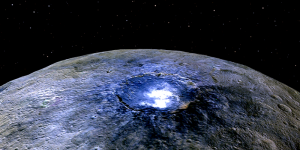
In 1801, while making a star map, Giuseppe Piazzi accidentally discovered a small object 1000 kilometers (600 miles) in diameter between the orbits of Mars and Jupiter. Piazzi named the object Ceres. It was the first asteroid to be discovered. In 1802, two more were discovered. Asteroids are numbered in order of their discovery and many have been named. For example, the first asteroid discovered is 1 Ceres, the second is 2 Pallas, etc. More than 400,000 asteroids have been discovered in the main asteroid belt.
In August, 2006, the International Astronomical Union passed a resolution redefining how celestial bodies are classified. Under this new classification system, Ceres is designated a dwarf planet because it orbits the Sun, has enough mass to form in a spherical shape, has not cleared the area around its orbit, and is not a satellite.
In 1801, while making a star map, Italian priest and astronomer Giuseppe Piazzi accidentally discovered the first and largest asteroid, Ceres, orbiting between Mars and Jupiter. Although Ceres is classified today as a dwarf planet, it accounts for a quarter of all the mass of all the known asteroids in or near the main asteroid belt.
Since about 2000, NASA has spearheaded a campaign to identify and track near-Earth asteroids. Programs like the Catalina Sky Survey in Arizona and the Pan-STARRS telescopes in Hawaii specialize in identifying these objects and have each discovered thousands of asteroids, according to CNEOS.
Asteroids are leftovers from the formation of our solar system about 4.6 billion years ago. Early on, the birth of Jupiter prevented any planetary bodies from forming in the gap between Mars and Jupiter, causing the small objects that were there to collide with each other and fragment into the asteroids seen today.
Understanding of how the solar system evolved is constantly expanding. Two fairly recent theories, the Nice model and the Grand Tack, suggest that the gas giants moved around before settling into their modern orbits. This movement could have sent asteroids from the main belt raining down on the terrestrial planets, emptying and refilling the original belt.
Credit : Space.com
Picture Credit : Google




